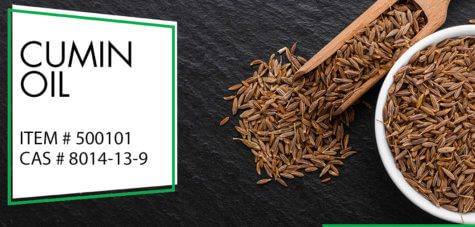Cumin Oil
Item#: 500101 CAS: 8014-13-9 FEMA: 2343
Odor Strength: Medium
Odor Description: Cumin, spicy, green, fatty, sweaty, herbal, aldehydic
Taste Description: Cumin, spicy, green, fatty, sweaty, herbal, aldehydic
Cumin seed is most known for its role in traditional North African and Middle Eastern cuisines. It is easily found in any grocery store here in the USA- ready to be used in Americans’ next internationally inspired-recipe. The spicy, earthy aromatic is also used in flavor and fragrance. Cumin oil was formulated in designer fragrances such as Pasha by Cartier, Comme des Garçons 2, and the polarizing Kingdom by Alexander McQueen.
Cumin, formally known as Cuminum cyminum, is native to the Mediterranean bassin. Today, it is grown in locations all over the world such as Egypt, Mexico, China, and India. Growers must wait roughly four months for cumin seeds to reach prime maturity before harvest. The seeds sit in delicate clusters of tiny flowers. To make harvest easier, and to optimize yields, entire flowers are typically snipped from the cumin. Then, seeds are shaken from the flowers, dried and taken to spice markets for export.
Cumin essential oil is produced by steam distillation. Crushed seeds are placed in a pressurized steam chamber, which releases the precious aroma chemicals trapped in the seeds blossom. The aroma compounds evaporate with the steam. Then, the steam carrying fragrant volatile molecules are condensed back into water as they travels through a cooling chamber. The less dense essential oil floats to the top of the decanting chamber, allowing the oil to be skimmed off of the water. Cumin oil is rich in valuable organic compounds such as cuminaldehyde and cymene.
Cumin oil has a spicy, earthy, slightly floral, yet animalic scent. Some oppose cumin oil, and describe its aroma as “sweat-like”. While cumin oil is most definitely an acquired scent, expert perfumers combine it with other warm spices like coriander, cinnamon, and clove for more palatable formulations
In flavoring, cumin is used to create seasonings and sauces, often those used to create North African, Middle Eastern, Latin American, or Indian inspired dishes. It is also used in a variety of ways to flavor prepared soups, meats, and more.
Cumin is revered in aromatherapy for its warming quality when on the skin. It also can aid in digestive distress and promote dental health.
If you are interested in seeing a sample or placing an order, please email Nicholas Bourne at nbourne@vigon.com or call 570-422-6026.

